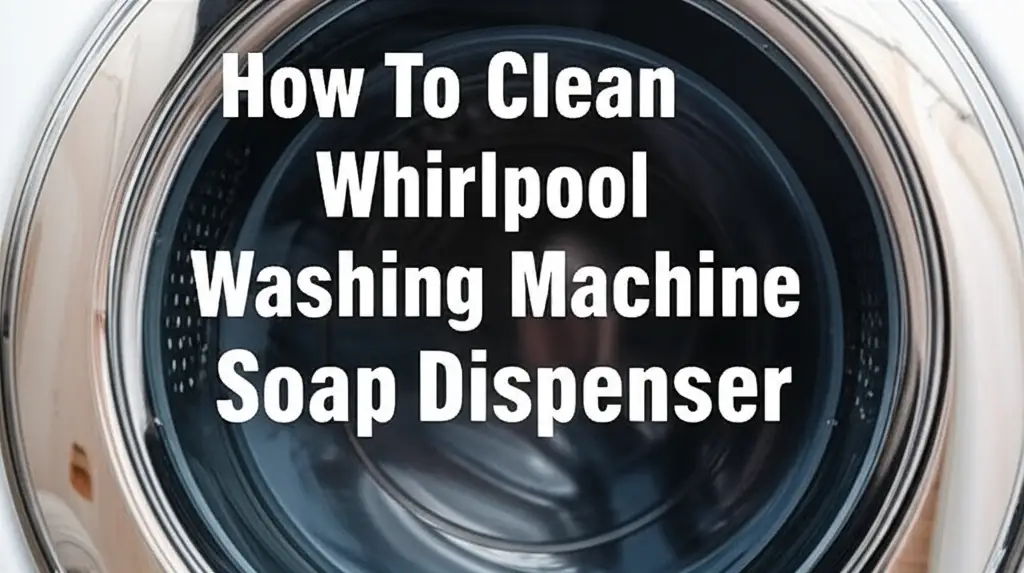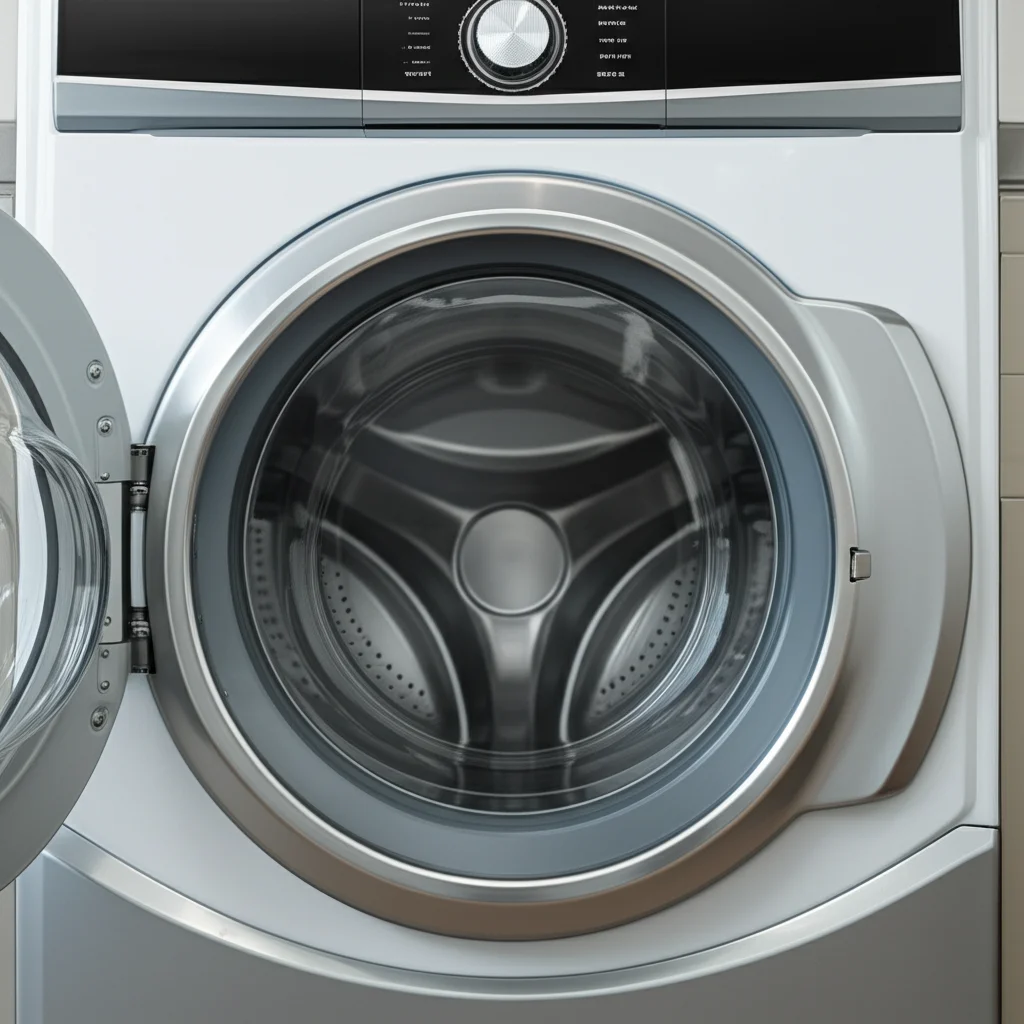· Todd Martin · Appliance Care · 15 min read
How To Clean Whirlpool Washing Machine Soap Dispenser

Effortless Cleaning: Your Whirlpool Washing Machine Soap Dispenser
Does your laundry not smell as fresh as it should? Perhaps you notice leftover detergent in the dispenser after a wash cycle. This common problem often comes from a dirty soap dispenser. Cleaning your Whirlpool washing machine soap dispenser is a simple yet crucial task.
A neglected dispenser can harbor old detergent, fabric softener, and mold. This buildup affects how well your washer cleans clothes. It can also lead to unpleasant odors or even blockages. I find that a quick clean makes a big difference. This guide will show you how to properly clean your Whirlpool washing machine soap dispenser. We will cover methods for different types of dispensers. You will learn about the right tools and cleaning solutions. We will also discuss how to keep your dispenser clean for the long run.
Takeaway
- Remove and Soak: Take out the dispenser drawer and soak its components in warm, soapy water.
- Scrub Away Buildup: Use a brush or cloth to remove all detergent and fabric softener residue.
- Clean the Housing: Wipe down the dispenser housing inside your washing machine thoroughly.
- Prevent Future Issues: Use less detergent, use warm water washes, and clean regularly.
To clean a Whirlpool washing machine soap dispenser, remove the dispenser drawer if possible. Soak the drawer and its inserts in warm, soapy water to loosen residue. Use a small brush or cloth to scrub away any buildup, mold, or mildew. Clean the dispenser housing inside the machine with a damp cloth.
Why Cleaning Your Whirlpool Dispenser Matters
Your Whirlpool washing machine works hard to keep your clothes clean. However, the soap dispenser often gets overlooked. This part plays a vital role in delivering detergent and softener. When it gets dirty, it can cause various problems. Neglecting it leads to issues that impact your laundry.
Over time, detergent and fabric softener can leave residue inside the dispenser. This residue becomes sticky and thick. It traps moisture, creating an ideal place for mold and mildew to grow. You might notice black spots or a musty smell. This growth is unhealthy and can transfer to your clothes.
A dirty dispenser can also affect your washer’s performance. Residue can block the dispenser’s nozzles or compartments. This means your detergent or softener might not dispense fully into the wash. Your clothes may not get as clean as they should. You might even find detergent stains on your laundry. This is why a clean soap dispenser is important for efficient washing.
Cleaning your dispenser regularly prevents these issues. It ensures proper detergent distribution. It also keeps unpleasant odors from developing. A clean dispenser means cleaner, fresher clothes. It also extends the life of your Whirlpool washing machine. This simple task contributes to better laundry results every time.
Gathering Your Cleaning Essentials
Before you start cleaning your Whirlpool washing machine soap dispenser, gather all your supplies. Having everything ready makes the process smoother. You probably have most of these items already in your home. I always make sure I have my tools before I begin any cleaning task.
First, you will need a few basic cleaning solutions. White vinegar is excellent for cutting through soap scum and dissolving mineral deposits. It also helps kill mold and mildew. Baking soda is another great natural cleaner. It acts as a gentle abrasive and helps neutralize odors. You might also want a mild dish soap for general cleaning. Avoid harsh chemicals or abrasive cleaners. These can damage plastic components. For tougher jobs, a small amount of household bleach can be effective. However, use it carefully and dilute it properly. You can learn more about general washing machine cleaning with bleach here: How To Clean Whirlpool Washing Machine With Bleach.
Next, gather your tools. A soft brush, like an old toothbrush or a small bottle brush, is essential. These brushes can reach into tight corners and crevices. You will also need a few microfiber cloths or old rags for wiping. A spray bottle can be useful for applying cleaning solutions. Finally, a small bucket or basin will be needed for soaking dispenser parts. Having the right tools ensures you can thoroughly clean every part of the dispenser.
Step-by-Step Guide: Cleaning a Removable Whirlpool Dispenser
Many Whirlpool washing machines have a removable soap dispenser drawer. This design makes cleaning much easier. If your machine has a pull-out drawer, this section is for you. I find this method the most effective for a deep clean.
Removing the Dispenser Drawer
The first step is to remove the dispenser drawer. Most Whirlpool top-load and front-load washers have a release tab. Look for a small button or lever, usually at the back or side of the drawer. Press this tab firmly while pulling the drawer out. The drawer should slide out smoothly. If it feels stuck, check for any clips or screws. Some models might require you to pull hard until it unclips.
Once the drawer is out, separate its components. Many dispensers have removable inserts for liquid detergent, powder detergent, or fabric softener. Take these inserts out one by one. This allows you to clean each piece thoroughly. Be gentle when pulling them apart. Some pieces may be brittle from age or dried soap.
Soaking and Scrubbing Components
After separating the parts, it is time to soak them. Fill a small bucket or sink with warm water. Add a few drops of mild dish soap or half a cup of white vinegar. Place all the dispenser components into the solution. Let them soak for at least 30 minutes. For heavily soiled parts, you can let them soak for a few hours or even overnight. Soaking helps to loosen dried detergent, fabric softener, and any mold. This step is crucial for making scrubbing easier.
Once soaked, use a soft brush or old toothbrush to scrub each component. Pay close attention to corners, crevices, and any areas with visible residue. The residue should come off easily after soaking. If you find stubborn spots, mix a paste of baking soda and a little water. Apply the paste directly to the grime and scrub gently. Rinse all parts thoroughly under running water. Make sure no soap or vinegar remains. Ensure all visible grime is gone.
Cleaning the Dispenser Housing
The dispenser housing is the area inside the washing machine where the drawer sits. This area can also accumulate grime and mold. After removing the drawer, you will see the empty housing. Use a damp cloth or sponge soaked in your cleaning solution. Wipe down the entire inside of the housing. Pay special attention to the top and back areas. These spots often collect water and residue.
For stubborn mold or mildew, you can use a diluted bleach solution (1 part bleach to 4 parts water). Apply it to a cloth and wipe the affected areas. Let it sit for a few minutes, then wipe clean with a fresh damp cloth. Make sure to rinse thoroughly to remove all bleach. Using a flashlight can help you see into darker corners. After cleaning the housing, allow it to air dry completely. This prevents new mold growth. Once dry, reassemble the dispenser drawer and slide it back into your Whirlpool washing machine.
Cleaning Fixed or Non-Removable Whirlpool Dispensers
Not all Whirlpool washing machines have removable dispenser drawers. Some models feature fixed dispensers. These dispensers are often part of the drum’s rim or a built-in compartment. Cleaning these requires a slightly different approach. While you cannot soak them, you can still get them very clean.
For fixed dispensers, you will need to clean them in place. Start by gathering your cleaning solutions and tools. A spray bottle filled with white vinegar or a diluted bleach solution is very useful here. You will also need a small brush, like an old toothbrush, and several clean cloths. I find using a small scrub brush with a handle helpful for reaching into deeper areas.
Begin by spraying the dispenser area generously with your chosen cleaning solution. Let the solution sit for 10-15 minutes. This allows it to break down soap scum and loosen grime. After soaking, use your brush to scrub all visible surfaces. Focus on the detergent and fabric softener compartments. Reach into any narrow openings or channels where residue might hide. You might need to rinse your brush often to clear away debris.
Once you have scrubbed, wipe down the entire dispenser area with a clean, damp cloth. Rinse the cloth often and repeat until no residue or cleaning solution remains. For any persistent stains or mold, you can apply a baking soda paste directly. Let it sit for a few minutes, then scrub and wipe clean. It is important to remove all traces of cleaning agents. After cleaning, leave the washing machine door slightly ajar. This allows the dispenser to air dry completely. Air drying helps prevent future mold growth. This method ensures your fixed dispenser remains clean and functional.
Tackling Stubborn Buildup and Mold
Sometimes, regular cleaning is not enough for heavily soiled dispensers. Stubborn buildup and mold can be challenging to remove. These issues require more targeted cleaning methods. I have encountered very tough grime in the past. It often needs a stronger approach.
For excessive soap scum and mineral deposits, white vinegar is your best friend. Vinegar’s acidic nature helps dissolve these tough deposits. If you have a removable dispenser, soak it in undiluted white vinegar for several hours. You can even leave it overnight. For fixed dispensers, spray vinegar directly onto the buildup. Let it sit for at least 30 minutes. Then, scrub vigorously with a stiff brush. Rinse thoroughly to remove all traces of vinegar and dissolved grime.
Mold and mildew can be particularly tough and unhealthy. If you see black or green growth, a bleach solution is effective. Mix one part household bleach with four parts water. Apply this solution to the moldy areas using a cloth or spray bottle. Allow it to sit for 10-15 minutes. The bleach will kill the mold and lighten the stains. After bleaching, rinse the area extensively with clean water. You must remove all bleach residue. Bleach can damage clothes if left behind. Always ensure proper ventilation when using bleach. Be careful not to mix bleach with other cleaners, especially ammonia, as it creates dangerous fumes. For concerns about general washing machine leaks, see Why Is My Whirlpool Washing Machine Leaking Water.
After addressing the worst of the buildup, perform a self-clean cycle or a hot water wash. Add two cups of white vinegar to the detergent dispenser. Run an empty hot water cycle. This helps flush out any remaining debris from the dispenser and internal lines. This method ensures all internal components are free from grime. Your Whirlpool washing machine will thank you.
Preventative Measures for a Clean Dispenser
Keeping your Whirlpool washing machine soap dispenser clean is easier than deep cleaning it. Regular maintenance prevents heavy buildup and mold. I find that a few simple habits make a big difference. These steps can save you time and effort in the long run.
First, always use the correct amount of detergent. Many people use too much soap. Excess detergent does not rinse away fully. It leaves sticky residue in the dispenser and on your clothes. Refer to your detergent’s instructions. Also, check your Whirlpool washer’s manual for recommended amounts. Liquid detergent often causes less buildup than powder. If you’re curious about using dish soap, be cautious; learn more here: Can Dish Soap Be Used In Washing Machine.
Second, use high-efficiency (HE) detergents if you have an HE washer. These detergents are low-sudsing and designed for less water. Using regular detergent in an HE washer creates too many suds. This leaves residue and can even damage the machine. Always match the detergent type to your washing machine model.
Third, run hot water cycles regularly. Hot water helps dissolve detergent and rinse away buildup. Cold water washes are energy efficient but can leave more residue. If you mostly use cold water, consider running an empty hot water wash with a cup of vinegar once a month. This flushes the system.
Fourth, wipe down the dispenser after each use. A quick wipe with a damp cloth prevents residue from drying and hardening. For removable dispensers, leave the drawer slightly ajar after a cycle. This allows air to circulate and prevents moisture buildup. Moisture creates a breeding ground for mold.
Finally, schedule a deep clean of your dispenser every one to three months. This frequency depends on how often you do laundry and the type of detergent you use. Consistent preventative measures will keep your dispenser pristine. This ensures your laundry always comes out fresh and clean.
Common Dispenser Problems and Troubleshooting
Even with regular cleaning, you might encounter issues with your Whirlpool washing machine soap dispenser. Knowing how to troubleshoot these problems can save you from bigger headaches. I have dealt with various dispenser quirks over the years.
One common problem is detergent not dispensing fully. This usually means the dispenser is clogged. Residue blocks the flow of water or the release of detergent. First, check if the dispenser is clean. If you just cleaned it, ensure all parts are reassembled correctly. Sometimes, small pieces can block the pathway. If the issue persists, run an empty hot water cycle with two cups of white vinegar. This can help clear internal blockages. If your washing machine has other leaking issues, you might find answers here: Why Is My Whirlpool Washing Machine Leaking Water From The Bottom.
Another issue is fabric softener remaining in the dispenser. This happens when the softener compartment is clogged. The siphon mechanism, which pulls the softener out, needs to be clear. Clean this area very thoroughly. Ensure the water pressure to your washing machine is adequate. Low water pressure might not be enough to flush the softener out. Sometimes, the softener is too thick. Dilute it slightly with water before adding it to the dispenser. Remember, cleaning the softener dispenser specifically is crucial: How To Clean Softener Dispenser In Washing Machine.
Leakage from the dispenser is also a concern. This can be caused by a few things. An overfilled dispenser is a common culprit. Always respect the “Max Fill” lines. Too much detergent or softener can lead to spills. A clogged dispenser can also cause water to back up and leak. Ensure the dispenser is completely free of blockages. Damaged seals or a cracked dispenser part might also cause leaks. Inspect the dispenser for any visible damage. If you find cracks, the part may need replacement. Sometimes, general washer leaks are related to dispenser issues, so understanding those can help: Why Does My Beko Washing Machine Leak From The Soap Dispenser.
If your dispenser is clean but still causing problems, check your water inlet hoses. Low water flow can impact dispensing. Ensure the water faucets are fully open. Also, check the inlet screens for clogs. A professional technician can help with complex mechanical issues. For simple problems, these troubleshooting steps usually help fix your Whirlpool dispenser.
FAQ Section
How often should I clean my Whirlpool washing machine soap dispenser? I recommend cleaning your Whirlpool washing machine soap dispenser at least once a month. If you wash clothes frequently or use liquid fabric softener often, clean it every two to three weeks. Regular cleaning prevents stubborn buildup. It also stops mold and mildew growth.
Can I use bleach to clean my Whirlpool soap dispenser? Yes, you can use diluted bleach to clean your Whirlpool soap dispenser, especially for mold or severe stains. Mix one part bleach with four parts water. Apply it carefully, let it sit briefly, then rinse thoroughly. Always ensure good ventilation and do not mix bleach with other cleaners like vinegar.
What if there’s persistent mold in the dispenser housing? For persistent mold, spray the area with a strong white vinegar solution. Let it soak for 30 minutes, then scrub with a stiff brush. Follow up with a diluted bleach solution if needed, ensuring thorough rinsing. Running a hot wash cycle with vinegar afterward helps flush out spores.
Why does my dispenser get dirty so quickly? Your dispenser might get dirty quickly due to using too much detergent or fabric softener. Overdosing leaves residue. Using regular detergent in an HE machine can also create excess suds and buildup. Make sure to use the correct type and amount of detergent. Also, wipe the dispenser after each use.
Can I clean my Whirlpool dispenser without removing it? Yes, you can clean fixed or non-removable Whirlpool dispensers. Spray white vinegar or a diluted bleach solution directly onto the dispenser. Let it sit for a few minutes. Use a small brush, like an old toothbrush, to scrub all surfaces. Wipe clean with a damp cloth.
Conclusion
Keeping your Whirlpool washing machine soap dispenser clean is a simple yet vital task. It ensures your clothes come out sparkling clean and smelling fresh. Neglecting this small part can lead to foul odors, detergent residue on clothes, and even machine malfunctions. I have found that regular attention to the dispenser makes a big difference in laundry results.
By following the steps outlined in this guide, you can effectively clean your Whirlpool washing machine soap dispenser. Remember to gather your tools, remove and soak dispenser parts, and thoroughly scrub away all grime. For fixed dispensers, direct spraying and scrubbing works best. Implementing preventative measures like using proper detergent amounts and wiping after each use will maintain its cleanliness. A clean dispenser means efficient washing and a longer life for your appliance. Make dispenser cleaning a regular part of your laundry routine. Your laundry will thank you!
- Whirlpool washing machine
- soap dispenser cleaning
- laundry appliance maintenance
- washer care
- home cleaning tips




